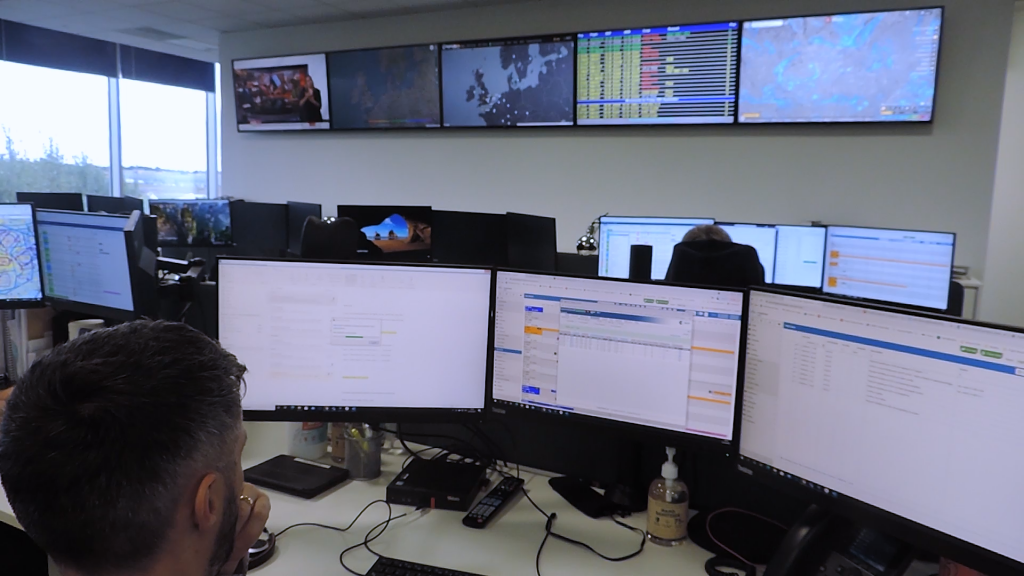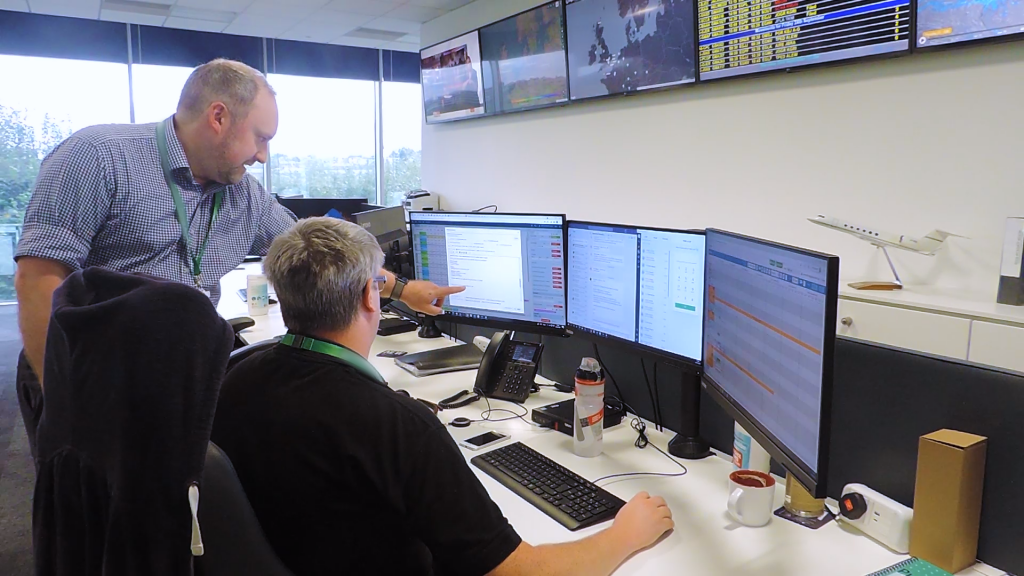Private aviation flight scheduling software has been slow to develop and adopt new technologies to make operations safer and more efficient.
Legacy systems are still used by most aircraft operators, and corporate flight departments especially, with concerns around migration cited as the number one reason for not upgrading to modern cloud solutions.
These older systems are essentially databases for storing and retrieving data when requested. New generation platforms however are designed to present situationally relevant data in an easily consumable interface to prevent the Operator being overwhelmed or overworked by the vast volumes of data available from integrated sources.
Harnessing modern technologies in automation, integration, app tools and powerful decision engines allows workflows to be optimized and teams to work more collaboratively. Embracing cloud hosting as part of this increases security and data privacy and enables secure and role-based remote working.
Gains in efficiency and safety across multiple departments, from Ops to Finance to Maintenance makes selecting the right Flight Operations system critical for any business.
Here we define the term ‘Flight Operations System’ and provide 7 best considerations for moving forward with modern Flight Operations software in your company.
What is a Flight Operations System?
Software that supports the highly complex management of flight scheduling and trip oversight, crew compliance and communication, customer data, charter and maintenance, in business and commercial aviation.
Depending on the system, capabilities can range from basic scheduling functionality to smart decision systems that pair context with data to give the Users all the information required at that moment to make informed decisions.

Knowing the difference between a basic legacy system and a modern flight ops platform can be difficult from face value, though an up-to-date user interface based on cloud technologies rather than on-premise is a strong indication.
Other components that set systems apart include the quality of the integrations to other systems such as flight planning and maintenance tracking tools, the amount of automation to remove time extensive and error prone manual intervention, and the economy and delivery of the service by the vendor.
Why is a Flight Operations System important?
A Flight Operations or ‘Flight Management’ System is necessary for running any Flight Department to reduce the complexity of regulatory compliance, trip planning, crew training etc. For the private aviation sector, ensuring the flight scheduling software is built for your operation is paramount to success.
The large number of tools and tracking services that ops teams must keep an eye on to ensure flight safety is too time consuming and risky to manage manually so these systems use automation, calculators and other tools to make work easier for the user.
Especially when overseeing multiple or entire fleets of aircraft, the flight ops system must scale to allow the user to easily keep an eye on their managed aircraft, subcharter aircraft, the maintenance and crew required to keep them flying, and the clients that they’re serving.
Additional features in cloud-based operations software include powerful integrated feeds to and from the platform to ensure a complete picture in real-time, with analytics and reporting capabilities providing the intelligence to maintain a cutting edge for the business.
“As a trip support company, we offer services with software by Universal, Honeywell and ARINC. The information that is already set in our [myairops] software, such as route, number of passengers, who the crews are, departure and arrival times and tail number, can be extracted and used to populate the flight planning software.
As a flight planner, whereas before we had to take the information from one source and type it into another system, we now don’t have too many boxes to fill and can avoid many keystrokes and simply tweak the final information to finally build the flight plan.”
Paul Cremer, Operations Delivery Manager, Gama Aviation
Excerpt from Business Airport International October 2021 (mydigitalpublication.co.uk)
From managing and communicating with crew, selecting fuel and ground handling, and providing trip cost quotations, to managing customer relationships and connecting your finances – the right flight operations system significantly reduces the complexity of flying.
What separates new Flight Operations Systems from the old?
- Cloud System or on-premise
Cloud based systems eliminates the need for hardware, on-site working, software administration and updates.
Data is stored far more securely than in on-premise desktop programs as hosting giants such as Microsoft manage protection and encryption.
Access to a multitude of different users, stakeholders, clients and partners is available from any web-enabled device with 2 factor authorization and editing rights restricted by role-based user controls.
2. Traditional legacy system vs modern solutions
Flight Operations systems have evolved at pace in the last few years.
Innovative data mechanisms, management workflows and planning tools are now built with accurate data at the fore and updated continuously in real-time to maximize aircraft and crew availability and safety.
At a fraction of the cost of traditional legacy systems, modern alternatives provide a lighter, refreshingly simple solution for accurate operations and safe crew management.
3. Quick wins when moving to modern systems
- Accessing their part of the systems and data anywhere in the world and on mobile devices.
- Cutting down the first manual processes via automation.
- Enjoying modern, intuitive and customized user interfaces with their drag and drop choice of data creating data tables to their specifications.
- Exporting data via one-click extracts or reports in the style the User has dragged and dropped the data or one of the many report formats they choose.
- Producing instant and attractive reports quotes, reports and more.
- Beginning to benefit from modern tools and processes and the efficiency they bring.
- Enabling in-system Trip Support to assign jobs and oversee progress of your Trip Support provider without having to leave the system.
The gains from then implementing the more advanced technologies increase over time.
After the initial wins above, the integrations with other systems and automation of processes and alerts begin to positively impact day-to-day efficiency and safety.
Data feeds into the system start to improve the accuracy of quotations; the examining of costs; the selection of suppliers.
4. Does it scale with your business
From a single aircraft to large multi-regulatory fleets, your system should scale with your business to improve and automate your operational processes.
In-system multi-fleet capabilities must allow your business the flexibility to maintain separate, customer specific lists. Modern, innovative, cloud-based infrastructure makes a system more easily scalable and cost effective than traditional legacy solutions.
5. Does it integrate with your other tools and systems
The modern system should be built on up-to-date API architecture for feeding data to and from your other systems and tools. You can then connect your flight planning, maintenance tracking, even your FBO system if you run any.
API connections to 3rd party data suppliers such as ADS-B tracking, weather, airport and FBO data, and Air Traffic Control give real-time view of information affecting the trip plan, the aircraft’s status, AOG warnings, aircraft actuals and utilisation, upcoming demand and much more. These are all essential especially when operating a private aviation flight scheduling software.
With two-way feeds, your Flight Planning team are pushed a vast array of situational data, without leaving their flight system.
6. Is the UI modern, clean, easy to use and attractive to new generations of workers
Staff should enjoy their user experience and not be limited by clunky legacy interfaces.
Modern user interfaces reflect the work the system is there to achieve by simplifying the complexity of flight operations and crew management.
Attractive, clean screens with mechanisms for task alerting, traffic light style oversight and dashboards allow the user to work effectively and to not be overwhelmed.
Analyzing data is critical to business and the system should help by allowing users to drag and drop grids into the format they wish to see in the system and export to a report, PDF or XML.
7. What is the caliber of support
The attraction to cloud-based systems is the freeing up of resources from traditional updating and maintenance of the software to focus on more beneficial uses of time.
Alongside 24/7/365 support, users can now expect a more consultancy-based approach where the software vender is tailoring the off-the-shelf solution to provide a more bespoke offering that matches your workflows and processes.
Modern software is updated regularly without downtime or expensive reinstallations, allowing the vendor to continuously evolve the system and improve the user’s experience over time.

A flight operations system is a collection of features and tools that make trip and crew management easier, faster and safer. Providing better services to achieve greater customer satisfaction comes from increasing efficiency and safety in your operations and eradicating mistakes.
More accurate data presented in real-time allows your operator staff to make informed decisions, leading to faster, smarter choices and ultimately better flight operations.
Legacy systems are being left behind as advanced technologies are brought into modern cloud platforms where real-time data is at the core.
To read more about the move from Legacy software to modern systems check out this recent whitepaper on the topic.
myairops is a flight operations, crew management, maintenance tracking and ground handling software platform with additional Trip Support, Maintenance and CAMO services available alongside, all from one provider and accessed from one system.
To learn more about the myairops products and services and how they fit with your business, visit myairops.com or speak directly to one of our consultants.





